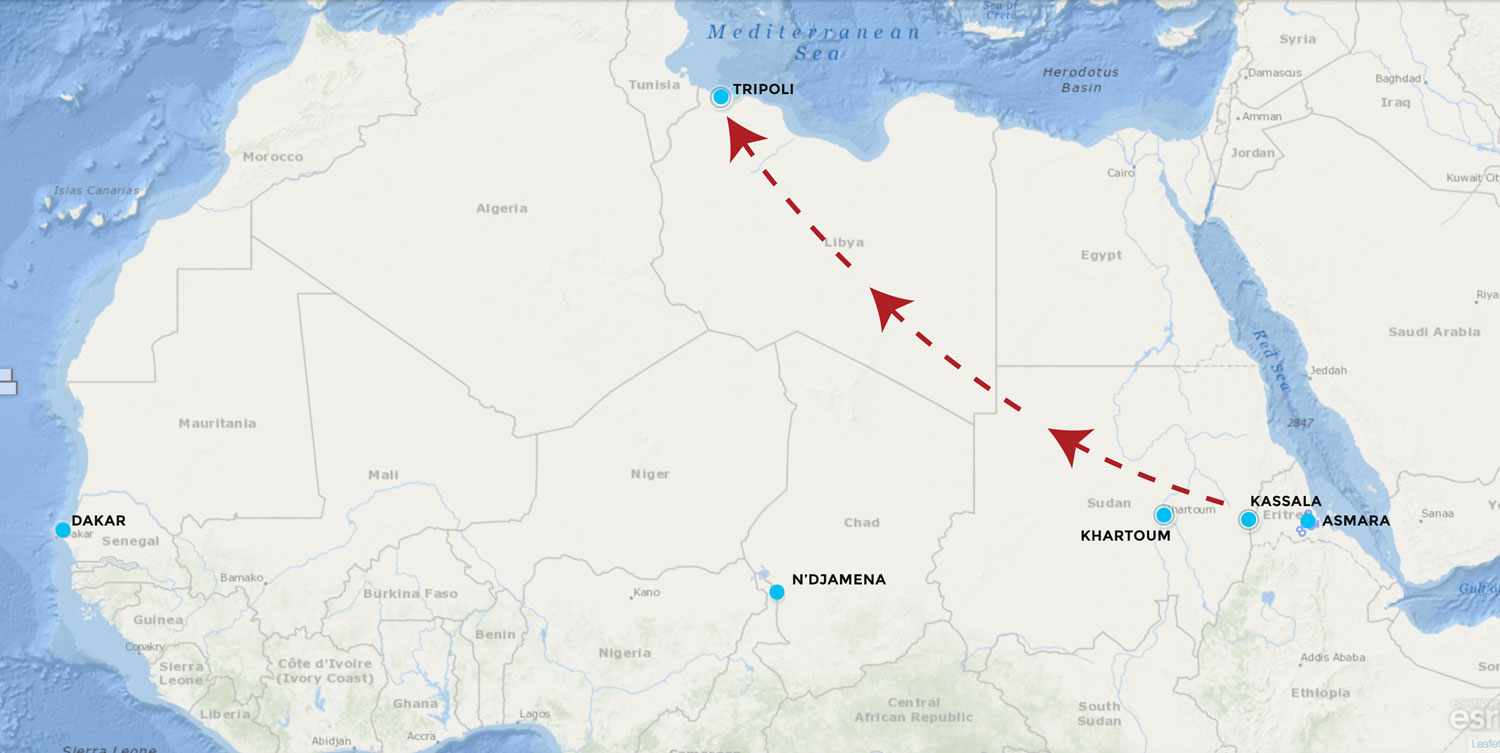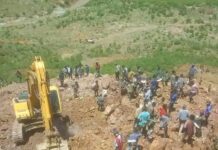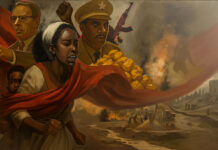By Sally Hayden
Nurah suspected her 13-year-old son was dead when the smuggler who claimed to be holding him hostage refused to put him on the phone. That was three years ago, but that series of events still runs through her mind every day.
Her son had left home, without warning and leaving no good-bye note or clue to his destination. Nurah was already anxious because just a month before, her older son had abandoned Sudan, hell-bent on making it to Libya and then across the Mediterranean Sea to Europe.
And then the angry man called, demanding a ransom of $2,000. “I said if my son was alive, I wanted to hear his voice, but they didn’t put him on,” she recalls, hunched over in a hot, cramped room in the Sudanese capital Khartoum, her eyes staring firmly at the tiled floor.
The case of Nurah – who requested we withhold her real name for safety reasons – is just one of many in Sudan, where young people are disappearing with startling frequency – encouraged by smugglers to leave for Europe without telling their parents, who they hope will pay the costs later.
A man approaches the fence which surrounds Shagarab camp in eastern Sudan, on July 20, 2017. Despite the fencing, security guards admitted anyone can access the camp. Residents worry Eritrean security will come after them there. (Photo by Sally Hayden)
Most want to go to Europe because it’s seen as the closest safe region, but that dream is becoming increasingly unlikely. Along with vast increases in European Union funding to Libya, Sudan and other countries aimed at stopping the flow of refugees, have come EU training for the Libyan coastguard to crack down on boats leaving from their shores, and new restrictions on nongovernmental search-and-rescue missions run off the Libyan coast.
However, that doesn’t mean desperate people will stay still. Reporting from central and eastern Sudan – a major origin, transit, and destination country – it is clear that many will continue to look for routes into a life with more security and opportunity.
In Kassala, on Sudan’s eastern border, and in Sudan’s capital, smugglers are easy to find. In Khartoum, they are the Eritreans that have cars, one refugee told me. In Kassala and in the refugee camps along the Eritrean border, smugglers come through recommendations – just ask a few people and you’ll get set up with one.
“Smugglers are very organized, it’s organized crime,” said Ismail Omer Teirab, deputy chairman of the National Committee to Combat Human Trafficking (NCCT). He believes that the gangs are often working with the security forces. “First they bribe policemen. Otherwise, they couldn’t go through the checkpoints.”
An Eritrean teenager sits on his bed in the unaccompanied minors section of Shagarab refugee camp, eastern Sudan, on July 20, 2017. (Photo by Sally Hayden)
For those like Nurah fleeing Eritrea because of forced military service or severe oppression, a journey from Kassala to Khartoum costs $300 to $450 for boys and men, and $750 for women whose families will pay more to ensure their safety.
For those wanting to carry on, the trip to Libya costs between $1,600 and $1,800, while getting the whole way to Europe from Khartoum will come to $4,000 to $5,000, a small fortune even for working refugees, who earn as little as $50 a month.
When a ransom is added, the price may climb much higher. If the deal goes wrong, some even end up paying with their life.
Many of the migrants who brave the voyage end up falling into the hands of militias who are operating a vicious slave trade inside Libya – a country with multiple governments and many tribes.
Refugees and migrants who unsuccessfully attempted the journey to Libya say that smugglers will often sell them on once they draw near the Libyan border. At that point, they no longer know who is in charge of them, and the terms of their “contract” can change. While some are held in detention, suffering malnutrition and often physical or sexual abuse, others are forced to work until their smugglers decide their debt has been paid off.
“Traffickers don’t keep their agreements. They’ll increase or double it and sell them to other traffickers,” said a 27-year-old Eritrean. His friends had set out on the journey, but cannot reach them to find out what happened to them. For him, Europe “is only a hope, a wish.”
The Khatmiyah mosque at the base of the Taka mountains in Kassala, Sudan, on July 19, 2017. The town is close to the Sudanese-Eritrean border which sees many refugees pass through. (Photo by Sally Hayden)
”Go now, ask for money later.”
The Central Mediterranean is currently the deadliest route to Europe. Some 600,000 people have crossed since 2014, while around 12,000 are feared to have died at sea. More than 2,700 are believed to have died so far in 2017.
Migrants and refugees who come through Sudan often originate in Eritrea, where they’re fleeing forced indefinite military service. In Sudan, their movements are limited. They claim they face harassment by the police, and those who manage to get permission to work are often paid very little, and much less than a local would get.
Often those who try to get to Europe are young, the second generation of refugees who came to Sudan, many Eritrean and Ethiopian migrants told me. They see their parents being paid low wages, and suffering discrimination, police brutality and corruption, and decide they don’t want the same life.
Meanwhile, smugglers search out young people and convince them to make the journey without telling their parents.
“Go now, ask for money later,” the smugglers tell them. “That way, no one can stop you.”
“I hid it from my family. I won't tell my parents until I get to Libya,” explained one 24-year-old woman with delicate features in Khartoum. She said her parents had properties in Eritrea they could sell, a sacrifice that would leave them with nothing. If she is caught, though, she knows they will have to pay. “I will be exposed to slavery and sexual violence if they don’t pay.”
A young girl stands in a dormitory in the unaccompanied minors section of Shagarab refugee camp, eastern Sudan, on July 20, 2017. (Photo by Sally Hayden)
Another 24-year-old, a nurse from Eritrea who wants to be a doctor, said she was aware of the dangers. “I know, but there is no more miserable life than this that I am now living,” she said. “I want a chance… a better life.”
Two weeks ago, her 18-year-old sister tried to follow her to Khartoum, but was kidnapped on the Eritrean border. They have been told the ransom is $5,000, an impossible amount, but they worry that if they don’t pay up, the girl will be moved up to the Sinai desert in Egypt. Among Eritreans, there are rumours that there is a trade in organ harvesting in that area, although the UN Special Rapporteur for Eritrea said she has not found enough evidence to prove those claims.
“There are many who tried to go to Libya and they are dead,” said Azgiamin Tesialassi, an Eritrean woman with braided hair, speaking in a dark, stone-walled room in a cheap neighbourhood popular with refugees. “Some are lost in the desert and some at sea. For those who are dead, no one can help.”
As we speak, she keeps repeating the words delalti haisebat – which means human smugglers in her language, Tigrinya. “Our children are being kidnapped by smugglers here.”
Boys sit in their dormitory in the unaccompanied minors section of Shagarab refugee camp in eastern Sudan, on July 20, 2017. (Photo by Sally Hayden)
Stopping the flow?
“If trafficking is business now, how can we make it non-profitable? I haven’t an answer,” Ismail Omer Teirab, NCCT deputy chairman said in an interview in Khartoum’s oldest hotel, the Acropole.
At least 100 people get through the Libyan border a month, Teirab estimates, though the exact statistics are impossible to know, because the area is so vast and impossible to fully monitor.
The NCCT was formed after Sudan brought in the much-lauded 2014 Human Trafficking Act. Teirab, a former teacher from Darfur, said he wants to run campaigns to educate refugees and Sudanese youth about the dangers of trusting their lives to people smugglers. However, he says he has received minimal funding, and hasn’t even been given enough for an office, other staff members, or a photocopier.
“Every day, young people see videos of Europe on their phones now, how can we combat that?” he asks.
Jeff Crisp, a research fellow at the public affairs think tank Chatham House and the former Head of Policy at UNHCR, said if the Mediterranean becomes impassible, smugglers may begin encouraging people to go in a different direction.
“It’s something a lot of people say: if one route closes, it diverts into another,” Crisp said. “[But] it takes a while between one route closing off and then people taking up a different route.”
During our investigation, we discovered evidence that some migrants from northern and east Africa are finding their way to South America, by routes much more circuitous and arduous. One Somali ended up in Mexico, after flying from Zambia to Brazil with a work visa. Another Somali travelled to Brazil from South Africa. In Colombia, Brazil and Mexico our reporters heard stories of Eritreans who had also passed through on their way to the United States.
Crisp said the current EU reaction towards Libya was motivated by political factors as well as increased visibility of the magnitude of the crossings.
“Panic is the word I would use for the EU response to the whole refugee and migration issue over the last three years,” he said. “It’s really not got its act together and its lurched from one thing to another.”
“I think everyone thinks that there’s an importance in appearing and talking tough,” he added.
Crisp said while it was obvious the EU was hoping people would no longer go on boats if there were no rescues off the coast, “that really depends on how much information they have and what the smugglers and traffickers tell them.”
Tekulu, an Eritrean 24-year-old in Khartoum hoping to make the journey north soon, said smugglers don’t tell refugees the truth about the risks involved with these journeys, or give them adequate information about what the situation on the other side might be. “With the traffickers – no one tells you exactly how people live as refugees and how they arrive. They just tell you things are good.”
Tekulu isn’t willing to shatter those illusions for anyone who might come after him. “Even if I tell them not to come, how can they stay here? It is good for me to keep quiet.”

Eritrean girls chat on a bed in a dormitory in the unaccompanied minors section of Shagarab refugee camp, eastern Sudan, on July 20, 2017. (Photo by Sally Hayden)
A migrant’s tale
It took two months for Helen to regain her memory after the first time she tried to get to Libya, so harrowing was what she witnessed.
The 22-year-old Eritrean had set off in a group of 87 migrants, all eager to move on from the discrimination and exploitation they experienced in Sudan. Now almost a third of them were dead. “All of us lost our minds,” she said. “We couldn’t remember where we had been.”
In a cramped, dark room in the Sudanese capital Khartoum, she sits slumped, her delicate features crumpling as she recounts a merciless odyssey from her home country to the desert in the north. As soon as she finished school, Helen, whose name has been changed for safety reasons, was forcibly recruited to work in Eritrea’s navy, a sentence with no end in sight.
So in 2015, she escaped, making it across the border and into Sudan.
It didn’t take long for her to meet a smuggler – the sort of man who watches closely for new arrivals in Khartoum. She was told a payment of $1,600 would get her to Libya, where she could pay the same again for a boat to Italy.
No one had to provide the money upfront, Helen explained. Once she arrived in Libya the smugglers would contact her parents in Eritrea and make them cough up the funds, a standard practice among migrants travelling from the Horn of Africa and a way smugglers encourage poverty-stricken young people to keep moving. Although she was ashamed to ask, Helen knew her parents had properties they could sell if she needed it.
The first hurdle came right outside Khartoum, where local security forces operate regular checkpoints. Helen says her convoy was stopped by military men – who she believes were Sudanese special forces – dressed in green khaki. She quickly learned they were also “thieves.”
The soldiers went through the group, confiscating their IDs before questioning them in turn. “The men investigated harshly. We were beaten. If you refused you would be beaten more,” says Helen, who showed us scars she still has from the interrogation.
Eventually, they withdrew and the migrants were alone again, just without papers, money and luggage. For Helen, losing her bags also meant the small amount of food she had with her was gone.
Yet they continued, travelling for another four days before reaching a series of high mountains. There was only one road that could lead them through, and again, they came across a check point and were threatened.
“We couldn’t identify them but they came to kidnap us,” she said of the soldiers, who she believes were either Sudanese or Chadian. Three of their vehicles were set alight during the fight and a number of drivers were arrested.
The smuggler she had travelled with managed to get away. The migrants were mostly injured and bloodied, speeding away from the clashes in their remaining vehicle. As they fled, one fell off the back of the truck onto the ground. No one stopped to help. “We don’t know what happened to him,” Helen said, although later she speculated that maybe that fall saved his life.
They drove for a long time before the vehicle broke down.
“We were in a very deserted area and had no way and means to go [anywhere]. We didn’t know which direction to go in. We spent about three days there without water and food. Most people struggled between life and death.”
Helen watched 26 of her companions die before a car stopped beside them and saved her life.
Now she’s back in Khartoum, but without an ID card or refugee status she feels vulnerable to abuse and exploitation.
At the moment, she’s receiving a monthly stipend from the UNHCR of 800 Sudanese Pound ($42), just over half of the cost of her monthly rent.
But despite the horrors of her first journey, Helen says she is ready to leave again. Eventually, she hopes to reach the UK. The first person to tell her parents she’s moved on will likely be a smuggler, phoning from Libya to demand payment.
Eritreans play pool in one of the makeshift pool halls in Shagarab camp in eastern Sudan, on July 20, 2017. (Photo by Sally Hayden)
The man trying to stem the flow, without a car, a photocopier or any staff
Ismail Omer Teirab has worked as the deputy chairman of Sudan’s National Committee to Combat Trafficking for the past two years, under a busy minister who acts as the figurehead.
In discussions about stemming migration from north Africa and the often-criticised EU-funding being funnelled towards countries in the region, his organisation has received a lot of attention. Founded after the Human Trafficking Act of 2014, it is mentioned again and again in discussions around the Khartoum Process, a dialogue between countries along the migration trails from north Africa to Europe. Under this initiative, the EU has given more than 200 million Euros to Sudan with the specific aim of stopping migration.
Better Migration Management (BMM), an EU-commissioned and funded programme backing the Khartoum Process, singled out Sudan’s NCCT as an example of a government-associated authority that the EU could work with. Its “Sudan concept” paper identifies the NCCT as a “window of opportunity” for the EU, and said it aims to empower it.
The organisation has also received vocal backing from the International Organization for Migration (IOM), who in their 2016 appeal asked for $1.3 million, in part to encourage the establishment of the National Coordination Mechanism on Migration which would support the NCCT on developing a National Action Plan.
But our interview with the man in charge of steering the Sudanese committee showed the body is underfunded to the point of being ineffective. In July, we met in my hotel, near the Blue Nile river and the city’s airport, because Teirab has no office. He says he needs five staff members, but that for the moment he’s on his own. He has no car and gratefully accepted an offer of 120 Sudanese Pounds, or $6.31, for the taxi home.
Teirab, a civil servant originally from Darfur who earns a teacher’s salary, speaks passionately about the problems smuggling is causing in Sudanese society. Despite his organisation’s title he thinks it’s important to highlight that according to his research there is no “trafficking” in Sudan – where migrants are exploited or forced into various forms of slavery to pay off the cost of the travel – only “smuggling”, the act of taking money to transport someone from one location to another.
But regarding the latter, he says it’s almost impossible to stop young people in Sudan from dreaming of Europe. They see pictures everyday on their phones, he says, holding up his rather battered looking Chinese-made device.
He believes the best way to combat smuggling would be through campaigns run online, on TVs and in schools, telling young people that “anything you see in phones and TV is false.”
He’d also like photocopiers and a four-wheel drive car so he can go to rural parts of eastern Sudan to meet with Eritrean refugees who have crossed the border, fleeing mandatory military service or oppression.
He complains that aid money on this issue is being disproportionately funneled towards the security forces: “The EU support the policemen and border force but not the NCCT,” he complains, saying that Brussels has already run six police training courses while he still tried to hobble together his action plan single-handedly. The EU did not respond to multiple requests for comment.
The risks for migrants and refugees travelling to Libya and across the Mediterranean to Europe have been well documented. Those who reach Libya can be sold into slavery, or held for ransom in detention facilities. If their families can’t pay it, some migrants are killed.
Children walk to school in Shagarab camp in eastern Sudan, on July 20, 2017. (Photo by Sally Hayden)
For those who can afford to pay their way on towards Europe, the risks are still high. At least 2,776 people have died crossing the Mediterranean from Libya this year, according to the IOM, making it the deadliest migration route in the world. Some of those who travel from Sudan die before they even cross the Libyan border. While in Khartoum, several refugees who made failed attempts to get to Libya told how they witnessed fellow passengers die en route.
In Sudan, discriminatory treatment of refugees also acts as a push factor, Teirab said. In Khartoum, Eritrean female refugees are sometimes sexually abused while working as maids in houses. In eastern Sudan, migrants are captured by tribes and held for ransom or sometimes brought to Egypt, where there are rumours that their organs are trafficked.
Like many Sudanese involved in refugee and migration-issues, Teirab was heavily critical of Europe, saying Sudan could support refugees internally but needs more help. “Sudan is like a pot. Let us keep them here inside Sudan. Sudan can receive more if necessary.” But first, he says, they need some resources.







